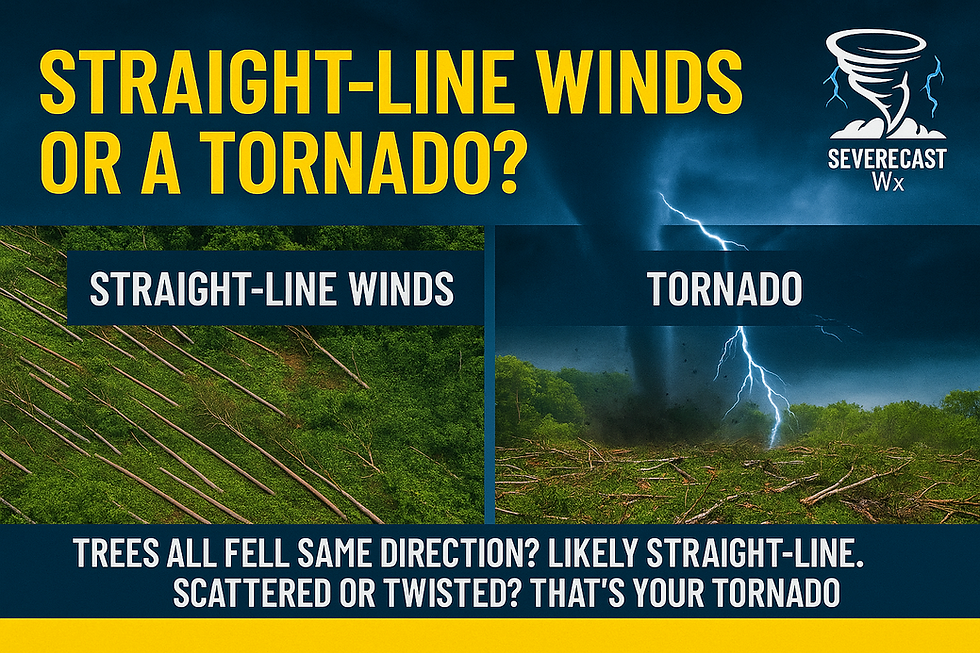Straight-Line Winds vs. Tornado Winds: What's the Difference?
- Nicole Carbone
- Jun 24
- 3 min read
In the wake of recent severe weather across the country, questions are pouring in about what exactly caused the damage, "Was that a tornado or just straight-line winds?"
It's a common question, and on that even seasoned storm spotters must carefully evaluate. Whie tornadoes get the headlines, straight-line winds are often the unsung culprit behind widespread destruction.
Let's break down the difference, how to identify the type of damage, and why you should never underestimate either.

WHAT ARE STRAIGHT-LINE WINDS?
Straight-line winds are powerful winds that descend from a thunderstorm and spread outward, often ahead of or along a line of storms. Unlike tornado winds that rotate, straight-line winds all move in one consistent direction, hence the name.
These winds typically form as a result of a downburst, a mass of cold air rapidly sinking within a storm and crashing into the ground, then fanning out across the landscape.
Types of straight-line winds include:
Downbursts: Localized bursts of damaging winds, sometimes topping 100 mph.
Microbursts: Small, intense version of a downburst.
Derechos: Long-lived wind events associated with fast-moving lines of thunderstorms, producing damage across hundreds of miles.
Key Characteristics:
Wind speeds can exceed 80-100+ mph (on par with EF-1 and EF-2 tornadoes).
Damage is typically wide and uniform
Often associated with severe thunderstorm warnings, not tornado warnings
WHAT MAKES A TORNADO DIFFERENT?
Tornadoes are violently rotating columns of air that extend from a thunderstorm cloud base (mesocyclone/supercell) to the ground. They form under very specific conditions, often involving wind shear, instability, and lifting mechanisms like fronts or outflow boundaries.
Key Characteristics:
Rotational winds swirl in a tight circulation
Paths are narrow, erratic, and may skip or zig zag
Damage often involves twisted or scattered debris
Even though tornadoes usually affect a smaller footprint, their wind speeds can be much higher than straight-line winds, sometimes exceeding 200 mph in violent Ef-4 or EF-5 cases.
TREE DAMAGE TELLS THE STORY
One of the best ways to tell the difference after a storm is to look at how trees and debris are laid out:
Straight-line Wind Damage
Trees and powerlines are pushed over in the same direction. Think of it like a giant invisible broom sweeping across a field. Entire rows of trees may fall like dominoes pointing the same way.
Tornado Damage
Trees are twisted, snapped, or tossed in multiple directions. You may see circular scarring on the ground or debris scattered in a swirl pattern.
Aerial footage and drone imagery have become extremely helpful for National Weather Service (NWS) damage surveys. By looking from above, meteorologists can quickly identify if the pattern is linear (straight-line), or rotational (tornado).
STRAIGHT-LINE WINDS CAN BE MORE DANGEROUS THAN TORNADOES
That might sound shocking, but it's true in some cases. Tornadoes tend to strike a relatively small area, while straight-line winds can impact entire counties or multiple states.
Consider this:
In 2020, a derecho slammed across the Midwest, producing wind gusts over 130 mph in parts of Iowa and Illinois.
Over 800,000 people lost power
Crops were flattened across millions of acres
It caused more than $11 billion in damage, making it one of the costliest thunderstorms in U.S. history.
Derechos are essentially wind hurricanes, without the tropical origin. And the scary part? People often don't take them as seriously because there's no "Tornado Warning" attached.
WHY THE CONFUSION?
Public confusion is common, and it's understandable. Loud winds, damage, sirens going off, these are high-stress situations. But here's why it matters:
Awareness helps people respond better in real time
Accurate reporting helps meteorologists issue better warnings
Damage assessments impact disaster declarations and insurance payouts
STRAIGHT-LINE OR SPINNING...BOTH CAN BE DEADLY
Let's be clear, tornadoes and straight-line winds are both dangerous. One is not "worse" than the other, they're just different. What matters is being prepared and not ignoring severe thunderstorm warnings just because the word "tornado" isn't mentioned.
Whether you hear Tornado Warnings or Severe Thunderstorm Warnings with 80+ mph winds,
Stay away from windows
Get low and put as many walls between you and the storm as possible
Have multiple ways to get alerts (WeatherCall, Weather Radios, etc.)





Comments